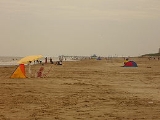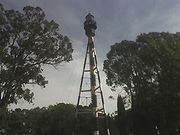
San Clemente del Tuyú
Encyclopedia

Argentina
Argentina , officially the Argentine Republic , is the second largest country in South America by land area, after Brazil. It is constituted as a federation of 23 provinces and an autonomous city, Buenos Aires...
town in the Partido de la Costa
La Costa Partido
La Costa Partido is a partido located on the Atlantic coast of Buenos Aires Province in Argentina.-Overview:The provincial subdivision has a population of about 60,000 inhabitants in an area of , and its capital city is Mar del Tuyú, which is located from Buenos Aires.The economy of La Costa...
district of the Province of Buenos Aires.
History
Noticed by Ferdinand MagellanFerdinand Magellan
Ferdinand Magellan was a Portuguese explorer. He was born in Sabrosa, in northern Portugal, and served King Charles I of Spain in search of a westward route to the "Spice Islands" ....
in 1520, who gave nearby Cape San Antonio
Cape San Antonio, Argentina
Cape San Antonio, or in Spanish Cabo San Antonio, is a cape extending into the Atlantic Ocean on the eastern coast of Buenos Aires Province in eastern Argentina. It lies south of Samborombón Bay.-References:...
its name, Spanish authorities first surveyed the area in 1580. Led by reformist Governor Hernando Arias de Saavedra
Hernando Arias de Saavedra
Hernando Arias de Saavedra , commonly known as Hernandarias, was a soldier and politician of criollo ancestry. He was the first American-born person to become a governor of a European colony in the Americas.-Early life:...
, his Guaraní staff christened the spot Rincón del Tuyú ("muddy corner"). First mapped by British
United Kingdom
The United Kingdom of Great Britain and Northern IrelandIn the United Kingdom and Dependencies, other languages have been officially recognised as legitimate autochthonous languages under the European Charter for Regional or Minority Languages...
Jesuit
Society of Jesus
The Society of Jesus is a Catholic male religious order that follows the teachings of the Catholic Church. The members are called Jesuits, and are also known colloquially as "God's Army" and as "The Company," these being references to founder Ignatius of Loyola's military background and a...
Thomas Falkner
Thomas Falkner
Thomas Falkner was an English Jesuit missionary, active in Patagonia.-Life:He was the son of Thomas Falkner, a Manchester apothecary, and obtained his education at the Manchester grammar school. Later on, having studied medicine under Dr...
in 1744, the neighboring stream was named San Clemente by Spanish
Spain
Spain , officially the Kingdom of Spain languages]] under the European Charter for Regional or Minority Languages. In each of these, Spain's official name is as follows:;;;;;;), is a country and member state of the European Union located in southwestern Europe on the Iberian Peninsula...
Jesuit José Cardiel.


Juan Manuel de Rosas
Juan Manuel de Rosas , was an argentine militar and politician, who was elected governor of the province of Buenos Aires in 1829 to 1835, and then of the Argentine Confederation from 1835 until 1852...
, had the area incorporated into a district of the Province of Buenos Aires in 1825, the area's first assigned jurisdiction since national independence in 1816; as Governor, Rosas brutally repressed a local insurrection in 1839 against his repressive rule. Following Rosas' 1852 overthrow
Battle of Caseros
The Battle of Caseros was fought near the town of Caseros, more precisely between the present-day train stations of Caseros and Palomar in Buenos Aires Province, Argentina, on 3 February 1852, between the Army of Buenos Aires commanded by Juan Manuel de Rosas...
, the area was given a county seat (Mar del Tuyú
Mar del Tuyú
Mar del Tuyú is a resort town and capital of the La Costa Partido, on the Argentine Atlantic Coast, with access to Provincial Route 11.- Overview :According to INDEC, the population of Mar del Tuyú was 6,916 in 2001, including...
) in 1864 and, with the arrival of abattoirs, the government had fishermen's docks, a canal between San Clemente and Buenos Aires
Buenos Aires
Buenos Aires is the capital and largest city of Argentina, and the second-largest metropolitan area in South America, after São Paulo. It is located on the western shore of the estuary of the Río de la Plata, on the southeastern coast of the South American continent...
, a railhead
Railhead
The word railhead is a railway term with two distinct meanings, depending upon its context.Sometimes, particularly in the context of modern freight terminals, the word is used to denote a terminus of a railway line, especially if the line is not yet finished, or if the terminus interfaces with...
and two lighthouses built between 1878 and 1902.
Prospering during the 1920s, the Argentine middle class first became widely aware of the idyllic coast through the efforts of Mayor Jorge Gibson, who had the local coastline graded into public beaches. The project's success led to the first gravel road into San Clemente in 1932 and its formal designation as a municipality; soon followed service stations, campgrounds, real estate developments, a power plant and even a monastery. President Juan Perón
Juan Perón
Juan Domingo Perón was an Argentine military officer, and politician. Perón was three times elected as President of Argentina though he only managed to serve one full term, after serving in several government positions, including the Secretary of Labor and the Vice Presidency...
made plans for a nearby submarine base that, though never built, resulted in a four-lane highway into San Clemente. This and continuing national prosperity led to the town's rapid development after 1950, which led to the establishment of a hospital in 1970 and of Mundo Marino
Mundo Marino
Mundo Marino is the largest aquarium in South America. It is in San Clemente del Tuyú, Argentina.-Attractions:* Show de Orca: The trainers of demonstrate how he can understand and communicate with games, rewards and mimicry....
in 1979, still the largest oceanarium
Oceanarium
An oceanarium can be either a marine mammal park, such as Marineland of Florida, or a large-scale aquarium, such as the Lisbon Oceanarium, presenting an ocean habitat with marine animals, especially large ocean dwellers such as sharks.- Marine mammal parks :...
in South America.
A nature theme park (Parque Bahía Aventura) opened in 1997; drawing few crowds, the area was slated for closure when, in 2003, mineral hot springs
Hot Springs
Hot Springs may refer to:* Hot Springs, Arkansas** Hot Springs National Park, Arkansas*Hot Springs, California**Hot Springs, Lassen County, California**Hot Springs, Modoc County, California**Hot Springs, Placer County, California...
were discovered at the spot. County Mayor Juan de Jesús set aside part of Bahía Aventura and opened Termas Marinas, today one of Argentina's most popular hot springs.
The city today
San Clemente del Tuyú, the northernmost among seven sea-side communities in the Partido de la Costa district, today counts 27 hotels (of which 14 are three or four-star establishments), the most important of which is the four-star sea-front Hotel Fontainebleu, with 71 rooms. The aquarium, adventure park and hot springs are complemented by two natural sciences museums, fishing boat tours and the 129 meter (400 feet) -long pier, among other parks and attractions. Punta Rasa, at the northern end of the city and the cape, was made a nature preserve in 1997. The activity around fishing boat tours centers around the black corvine feast held annually since 1966, towards December. The area's vast dunes also set the stage for the annual EnduroEnduro
Enduro is a form of motorcycle sport run on courses that are predominantly off-road. Enduro consists of many different obstacles and challenges...
competition held here every February since 1998. A small but loyal contingent of visitors also arrives seasonally from San Clemente, California
San Clemente, California
San Clemente is a city in Orange County, California. The population was 63,522 at the 2010 census. Located on the California Coast, midway between Los Angeles and San Diego at the southern tip of the county, it is known for its ocean, hill, and mountain views, a pleasant climate and its Spanish...
, a sister city of San Clemente del Tuyú since 1969.
The seven sister communities receive nearly a million visitors monthly during the peak summer season (January and February), of which San Clemente del Tuyú hosts roughly one tenth, given its proportion of the district's hotel room availability. A considerable number of summertime visitors also come to enjoy Benedictine
Benedictine
Benedictine refers to the spirituality and consecrated life in accordance with the Rule of St Benedict, written by Benedict of Nursia in the sixth century for the cenobitic communities he founded in central Italy. The most notable of these is Monte Cassino, the first monastery founded by Benedict...
monk Mamerto Menapace's sermons and lectures, which takes place at the order's San Clemente estancia and offers ascetic "pilgrim" accommodations. San Clemente del Tuyú hosted the Sixth Iberoamerican Congress on Environmental Education in September 2009.

